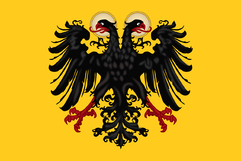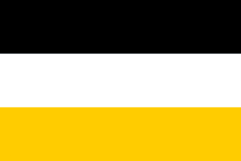Flags of Biggonia
Considered by most as the birth place of the earliest humans, as well as being an early location of urbanisation and development of civilisations, it is no surprise that Biggonia has a long history of flags and symbols which have been used to represent the nation over the years. The history of the early Biggonian clans and petty kingdoms is poorly documented, and virtually no useful symbols and indications about what banners were used to represent the polities can exist. Therefore the earliest flags used to represent Biggonia are those of the Ancient 1st Biggonian Empire, mythically founded in 753 BC.
Imperial Flags
Blahdy blah
First Biggonian Empire (753 BC- AD 376)
Biggonian Confederation (1847-1901)
Second Biggonian Empire (1901-2023)
The official flag of the new Biggonian Empire was officially adopted by the Biggonian Confederation as the 'future' flag of Biggonia after heated discussions within the Confederation. From the start, many opposed the flag as it was simply the same as the Talland flag, and would suggest a pre-eminent position for the Kingdom of Talland. However, this was countered by some nationalist thinkers who believed that rather than representing Talland as a province, it represented the Tallandos dynasty, which the flag was right to do so as they were sacred Emperors annointed by God. Some also countered by arguing that the Biggonian Confederation's flag should remain in place, however this was strongly rejected by nationalists who said that Biggonia as a unified nation was separate from the Biggonian Confederation, and to symbolise this change required a new flag. Ultimately the flag was recognised as the future flag in 1896.
The Biggonian Imperial flag remained the symbol of Biggonia for the entirety of the 20th century in a completely unchanged form. Its use became popular with emigrants abroad as well, until it was largely replaced by the Pan-Biggonian flag over the 1970s. Many emoji keyboards, especially on older operating systems, continue to use the Biggonian Imperial Flag rather than the modern Commonwealth flag. Virtually every single textbook in existence still features the Imperial flag as opposed to the Commonwealth flag due to the recency of the flag change (this was written in July 2024.) Although the double headed eagle started as a simple symbol of the Tallandos house, by 2023 it was used as a symbol of Biggonia in general, especially during the Interregnum period (2021-2023) as the two heads were mocked by satirists as symbolic of the infighting within the Biggonian government.
The Biggonian Imperial Flag was finally phased out of active use on the 26th October 2023, when the Biggonian Empire officially adopted the new constitution of the Biggonian Commonwealth. In spite of this, the flag remains legal for personal usage, however intelligence services heavily scrutinise it for signs of extremism. In the Domlandian Social Republic, flying of the flag is banned and punishable by up to 5 years in jail.
Biggonian Commonwealth (2023-present)
Biggonian Provinces
Wow!
Talland
Suddereich
Abakhan/Grenzland
Seltsamia
Kudestadt
Others
These ones are INSANE
Pan-Biggonian Flag
The Pan-Biggonian flag was first devised by -------, a man of Biggonian descent who lived in Buchbach in 1969. Although still proud of his Biggonian heritage and identity, ------ had grown dissolusioned with the Biggonian Empire owing to the international pariah status of Josef I's regime; especially after the three failed invasions of Domlandia. Whilst ----- himself was not an emigrant, the growing awareness of Biggonian economic emigrants and the continued existence of Biggonians in the former colonial empire had encouraged feelings of nationalism across the Biggonian extraction community, even though they themselves did not live within Biggonia. This feeling of nationhood across the wider Biggonian community (which was later taken up by some in the Biggonian Empire proper) came to be known as Second-Wave Pan-Biggonianism.
The flag is laden with symbolism, arguably moreso than any other Biggonian flag as it lacks noble crests which litter the other flags. The top black bar of the flag is meant to emphasise the feeling of disconnect which modern Biggonians feel from any single nation, thanks to their politically problematic motherland and lack of integration from the new nations they found themselves in. This is meant to emphasise the black hole within their hearts and longing for some new kind of unity. By contrast, the yellow bar at the bottom remains as a reminder of their old homeland in Biggonia, and serves two purposes. Firstly, it is a simple colour of Biggonia as it had featured on their flags since the Biggonian Confederation of 1847. However, by using the colour which had by the 1960s come to represent the dictatorial regime in domestic Biggonia, it shows an attempt to reclaim the symbol from a government which no longer represented the Biggonian people. Finally, the white colour of the flag serves little purpose apparently. When interviewed about it ten years on, ----- said "I'm not sure why I put it in there. It serves as a nice balancer between the yellow and the black. I imagine people can invent their own symbolic reason why its there."
The Pan-Biggonian flag became incredibly popular across the world, and in 1979 during the Biggonian Spring after Josef I's death it was officially recognsied by the IBO (International Biggonian Organisation) as the Pan-Biggonian flag. In 1987, the IBO then changed their logo to include the Pan-Biggonian flag rather than the double headed eagle. In 2023, when the Biggonian Commonwealth designed a new flag, it was seen as taking many design inspirations from the Pan-Biggonian flag, such as the inclusion of a horizontal tricolour. Thankfully for many, the government did not simply adopt the flag; allowing Biggonian emigrés to continue flying the flag at home in an apolitical context. Today the Pan-Biggonian flag is believed to be amongst the most commonly flown non national flags in the world.

